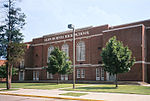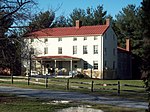Cromwell / Glen Burnie station

Glen Burnie station (formerly Cromwell / Glen Burnie) is a Baltimore Light Rail station in Glen Burnie, Maryland. It is one of the system's two southern terminals, and one of two stations in Glen Burnie. Trains depart Glen Burnie bound for Timonium station (during peak commuting hours on weekdays) or Hunt Valley station (at all other times). Unlike the nearby Ferndale station, there are currently 795 free parking spaces and connections can be made to MTA Maryland's Route 14 bus from here. South of the station, the lines terminate on an embankment on the northwest corner of Maryland Route 648 and Maryland Route 176 to the east of Interstate 97, and the right of way is replaced by the Baltimore and Annapolis Rail Trail.
Excerpt from the Wikipedia article Cromwell / Glen Burnie station (License: CC BY-SA 3.0, Authors, Images).Cromwell / Glen Burnie station
Baltimore Annapolis Boulevard, Glen Burnie
Geographical coordinates (GPS) Address Nearby Places Show on map
Geographical coordinates (GPS)
| Latitude | Longitude |
|---|---|
| N 39.172355555556 ° | E -76.633447222222 ° |
Address
Cromwell/Glen Burnie
Baltimore Annapolis Boulevard
21060 Glen Burnie
Maryland, United States
Open on Google Maps






